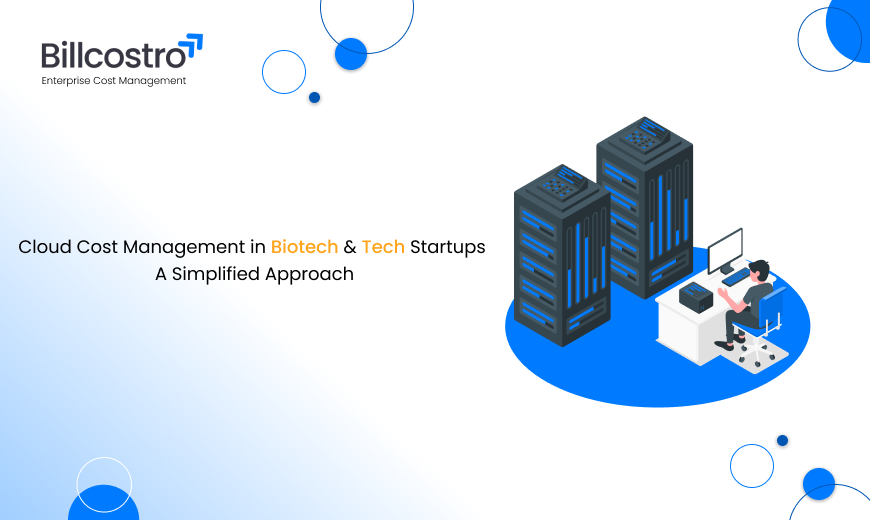
Aug. 30, 2025, 6:40 a.m.

Biotech and tech startups are heavily dependent on cloud computing, as it offers them the advantages of scalability, flexibility, and rapid innovation, which they typically achieve without the need for heavy upfront infrastructure costs. However, it is also true that the cloud has become a significant source of concern for startups in terms of rising and volatile costs.
Startups are in a situation where every rupee (or dollar) is crucial to them. If cloud spending is mismanaged, it can cause the company’s profits to decline at an alarming rate, which in turn can lead to a contraction in the company’s pace of expansion and the necessity to allocate funds to areas other than innovation. This is why cloud cost management is not only a finance problem but also a survival strategy.
This blog will provide an introduction to the cloud cost management process, accompanied by real-life examples of key issues faced by biotech and tech startups. Additionally, the blog will discuss some cost-control practices implemented by startups to manage costs efficiently.
Cloud providers such as AWS, Google Cloud, and Azure implement a pay-as-you-go system. Although this adaptability is excellent, startups are regularly caught in situations that eventually lead to cloud overspending.
Below are the main causes:
In contrast to large enterprises, biotech and tech startups operate with a limited amount of money, under the strict supervision of investors, and have shorter distances to cover before they become profitable. Every unnecessary expense is a delay in reaching a growth milestone.
Efficient cloud cost management allows startups to:
One way startups can exert control over their cloud consumption is by avoiding excessive tools designed primarily for large enterprises.
1. Start with Cost Visibility
"The say goes that you can't govern what you can't see." The very first step will be to access where money used for cloud services is going. You can analyze spendings by:
Such a step helps uncover the portions of the budget that soak up your money and thus identify planning priorities.
2. Rightsize Resources
The majority of startups have the tendency to provision more computing power than necessary for them to be secure in their decisions. A monitoring tool will help you know which resources are being utilized and thus you be able to downgrade those instances which are not used or are too big. Just this one move can be enough to shave off about 20–30% of the costs.
3. Automate On/Off Scheduling
Workloads which are non-critical, such as the testing environment or the overnight batch jobs, should not be that way, i.e., 24/7. A shutdown that happens automatically during off-hours will prevent wastage.
4. Adopt Reserved & Spot Instances
Cloud providers give discounts for reserved capacity of long duration or for spot usage, which is of a short duration. A wise combination of these choices will save a lot of money without compromising performance.
5. Optimize Storage Costs
Biotech data moves so quickly that the datasets (such as genomics and clinical trial data) grow quite large in a short time. However, if they wanted to keep all data in efficient, high-performance storage, then the costs would skyrocket. So, they now use tiered storage (hot, warm, cold) based on usage frequency.
6. Monitor Shadow IT
At times, units might buy cloud services directly without informing the IT department. Owing accountability to the centralized purchasing and setting of approval workflows will not only make the incidence of shadow IT less likely, but it will also reduce hidden expenses.
7. Set Budget Alerts
Simple budget limits and automatic alerts can help stop excessive expenses. For instance, if expenditure exceeds 80% of the budget for a month, the alerts can inform the teams immediately.
8. Align Cloud Spend with Business KPIs
Why not just see the cloud as a technical cost, instead of tying it to results:
Biotech startups have to deal with cloud costs in a special way that is quite different from other tech startups, and these are some of the main reasons:
Answer: Biotech startups should allocate a significant portion of their efforts to managing the data lifecycle – moving unaccessed datasets to storage with lower costs and maintaining strict retention policies.
Read more: The Role of Cloud-Based Cost Management Software in Business Scalability
Tech startups, especially SaaS and AI-based companies, suffer from:
Third-Party Tool Overlap – The use of various tools for analytics, monitoring, and CI/CD along with the existing software, can be the reason for the hidden costs that keep increasing.
Solution: The technology startups need to implement the FinOps model, whereby the engineering, finance, and business teams work together to make decisions about the cloud.
Cloud cost management, if done rightly, not only saves a startup time and money but also strengthens its basic foundation :
The management of cloud costs may appear complicated, yet if startups employ the proper methods, they can effectively combine innovation with financial discipline. Although cloud-native tools facilitate monitoring of consumption, startups are still required to have comprehensive cost visibility, which should not be limited to the cloud alone.
This is the point at which Billcostro becomes the solution. Billcostro enables startups not only to monitor and control office expenses but also to track payments to vendors and identify cost leakage, in addition to cloud spending. Through the use of financial visibility tools like real-time dashboards, invoice matching, and spend workflows, biotech and tech startups gain the total financial visibility they need, which in turn enables them to focus on the cost-to-revenue ratio and maintain profitability.